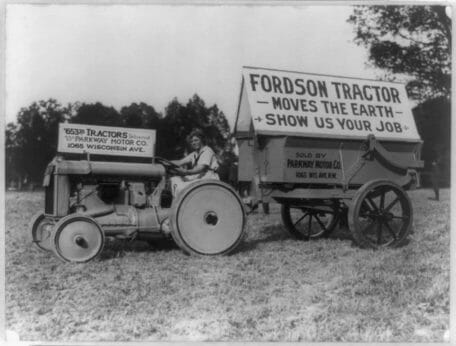Henry Ford's Model F tractor turned 100 this year. John Deere tractors are celebrating the same landmark in 2018. Let's celebrate!

Fordson fans (that’s the brand name of Ford’s original tractors) from Australia to the UK have staged major hoedowns over the past year. Should you find yourself in the Detroit area, stop in at the Ford family estate in Dearborn, where there is a special tractor exhibit to commemorate the centennial. For the under-12 contingent, special edition toy tractor sets have been issued to mark the occasion. The Smithsonian has even declared 2018 as the Year of the Tractor, and will be showcasing a vintage John Deere model at the National Museum of American History in D.C.
Here at Modern Farmer, we thought we’d celebrate with a little cruise down memory lane.
[mf_h2 align=”center” transform=”uppercase”]1850s: John Fowler and Company – Steam Tractor[/mf_h2]
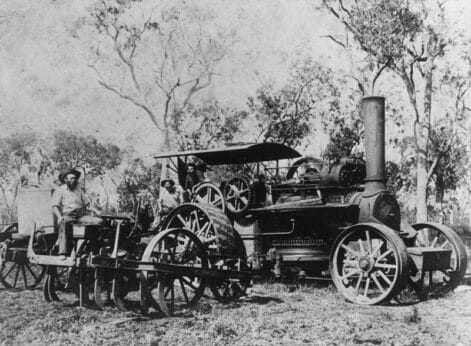
The design of this steam-powered tractor is inspired by steam locomotives of the time. Photo Credit: John Oxley Library, State Library of Queensland.
Inventors tinkered with the idea of a steam-powered tractor throughout the 19th century, but the British Engineer John Fowler is credited with introducing the first commercially-viable models in the 1850s, one of which is pictured above. If it reminds you of a steam locomotive, that’s because the design is derived from the trains of the day.
[mf_h2 align=”center” transform=”uppercase”]1890: Holt Manufacturing Company – Crawler Tractor[/mf_h2]

Crawler-track type designs like this performed better in wet fields. Photo Credit: Caterpillar Company
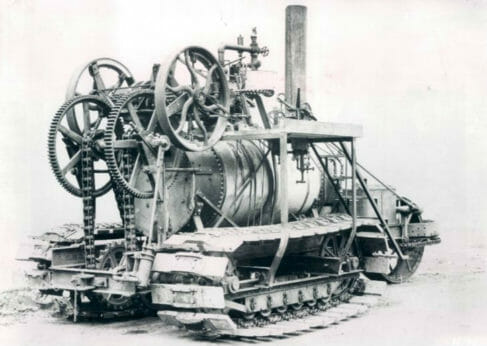
Photo Credit: Caterpillar Company
Early tractors had enormous steel wheels that were unimaginably heavy and had poor traction. To improve performance in wet conditions, Benjamin Holt came up with the design for the crawler-type tractor – the steam-powered model pictured here had wooden tracks – toward the end of the 19th century. His company eventually became Caterpillar, which continues to make track-based farm and construction equipment today.
1892: Waterloo Gasoline Engine Company – Gas-Powered Tractor[/mf_h2]

Waterloo Gasoline Engine Company’s Gas-Powered Tractor
Photo Credit: FarmCollector.com
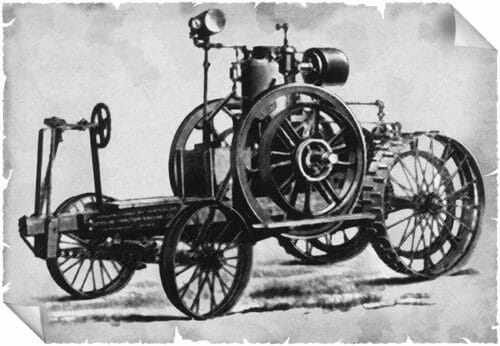
Waterloo Gasoline Engine Company’s Gas-Powered Tractor
Photo Credit: FarmCollector.com
Steam-powered tractors were heavy, clunky, and never became widely used. Hoping for a more maneuverable design, Iowa inventor John Froelich came up with the first gasoline-powered tractors in the 1890s. These didn’t catch on immediately either, though Froelich’s tractor outfit, the Waterloo Gasoline Engine Company, was eventually purchased by John Deere. (Because 2017 is the quasquicentennial – translation: 125th anniversary – of this important event, the Froelich Museum in Froelich, Iowa recently had a big celebration.)
[mf_h2 align=”center” transform=”uppercase”]1906: Hart-Parr Tractor Company ”“ First “Tractor” Tractor[/mf_h2]
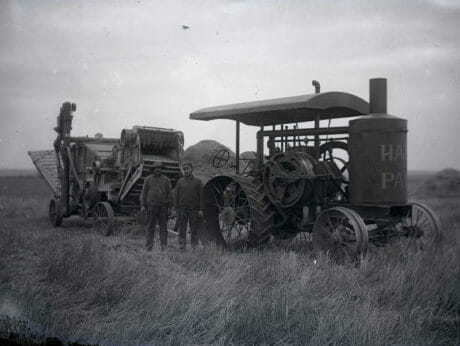
A print from a glass plate negative of a 17-30 Hart-Parr tractor. Photo Credit: <a=”https://www.smokstak.com/forum/showthread.php?t=152121″>Smokstak.com
Tractor development was picking up by the turn of the century, with more and more companies getting into the business. One of those was Hart-Parr, which was established in Iowa in 1901. In 1906, looking to differentiate their machines on the increasingly crowded market, the owners decided to call their machines “tractors.” Previously, everyone referred to them as “traction engines.”
[mf_h2 align=”center” transform=”uppercase”]1917: Fordson ”“ Model F[/mf_h2]

The Model F tractor was nicknamed the “Model T of the Soil.” Photo Credit: WikiCommons
Most Americans are familiar with the Model T Ford, the first affordable, mass-produced car, which was introduced in 1908. But other than agricultural history buffs, few realize that Henry Ford also had a wildly successful line of tractors, which he launched under the name Fordson in 1917. Ford called the Model F, his first successful design, the “automobile plow,” and agricultural commentators of the day hailed it as the “Model T of the soil.” Selling for about $750, it soon gained a reputation among farmers as cheaper than horses to own and maintain, setting tractors on a trajectory to outpace livestock as the primary source of farm power over the next few decades.
[mf_h2 align=”center” transform=”uppercase”]1918: John Deere ”“ Waterloo Boy Tractors[/mf_h2]
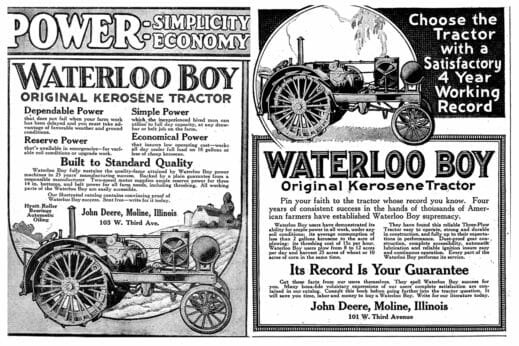
Advertisements for the John Deere Waterloo Boy kerosene Tractor from 1918. Photo Credit: Don O’Brien
John Deere, the man, was born in 1804. A blacksmith, he started manufacturing agricultural implements in 1837. Deere became famous for his horse-drawn plows, but was long dead by the time his company started selling tractors in 1918, the year they acquired Froehlich’s outfit, the aforementioned Waterloo Gasoline Engine Company. At the time, their most popular model was known simply as the Waterloo Boy, though this was soon replaced with a John Deere-branded machine. The company quickly grew into the largest tractor manufacturer in the world.
[mf_h2 align=”center” transform=”uppercase”]1923: International Harvester ”“ The Farmall[/mf_h2]
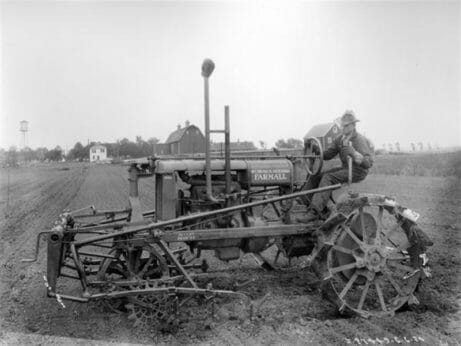
Photo Credit: Wisconsin Historical Society
The introduction of International Harvester’s Farmall line of tractors in 1923 is considered a watershed moment for the modern tractor. Earlier machines were designed primarily for one specific task. The Farmall, on the other hand, did it all: plowing, harrowing, seeding and more. The key to this was the invention of the PTO (power takeoff) shaft, which transferred power from the motor to any number of implements pulled behind the tractor. Up until this time, farmers typically kept a team of horses for any tasks that their tractor couldn’t handle, but the PTO liberated farmers to fully embrace machine power.
[mf_h2 align=”center” transform=”uppercase”]1939: Fordson – Model N[/mf_h2]
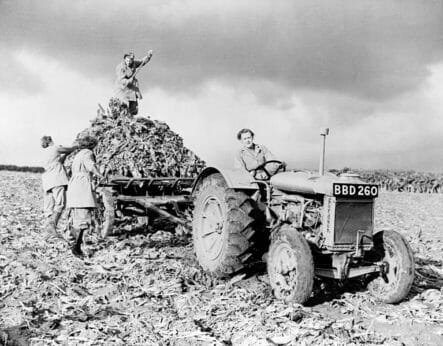
Members of the British Women’s Land Army harvest beets during WWII. Photo Credit: British Ministry of Information, from Fox Photos.
One final feature that cemented the basic design of the modern tractor was the three-point hitch – little more than a triangle of metal at the back of the tractor for attaching implements (most modern tractors have both a PTO shaft and a three-point hitch, which are used for mounting different types of equipment). The three-point hitch is typically attached to a hydraulic system that can lift heavy implements off the ground when not in use, saving a farmer’s back. The concept had been around for many years, but the Fordson Model N series, which debuted just as World War II began (the women above are harvesting beets while their husbands were at war), is considered the machine that perfected modern tractor design – and little has changed in the intervening years.
